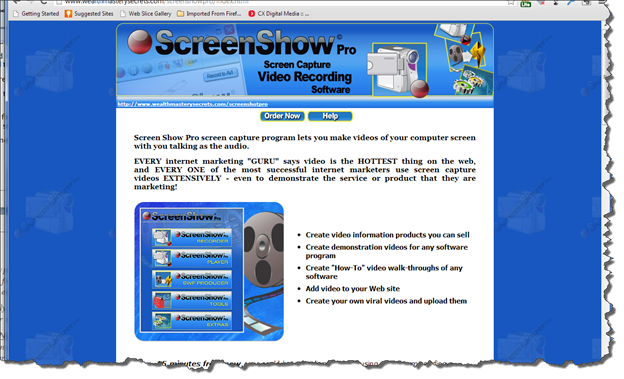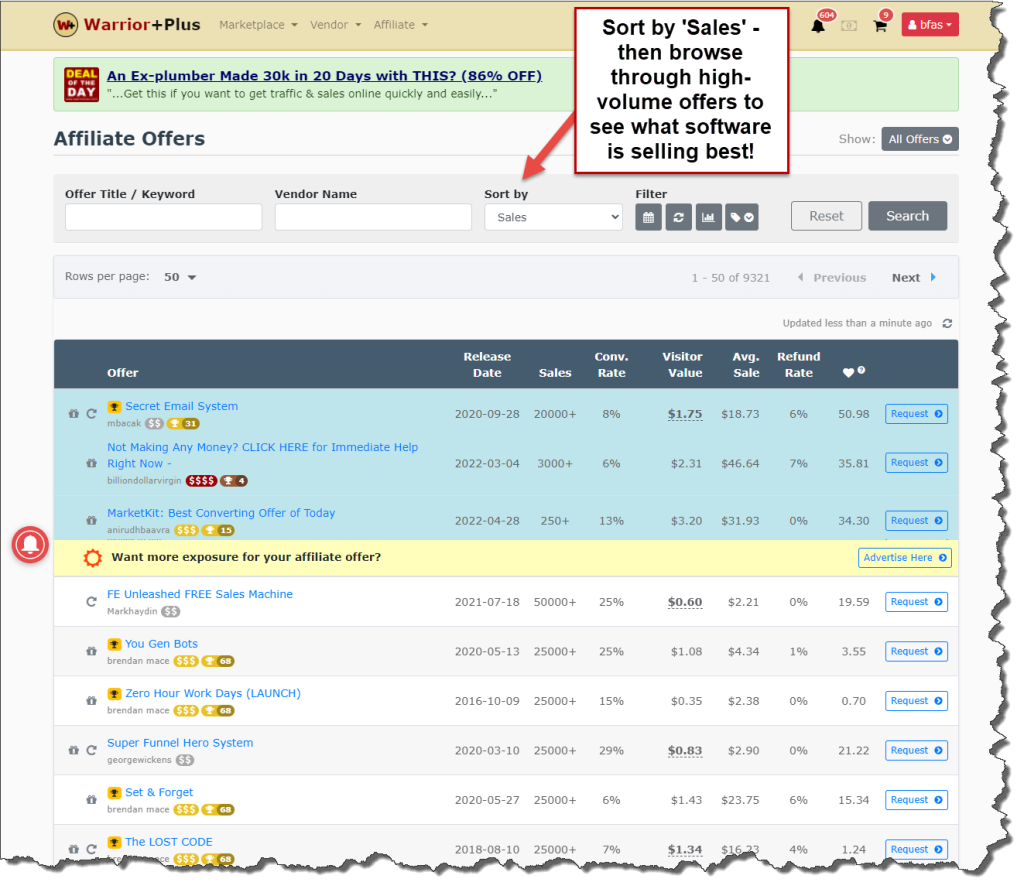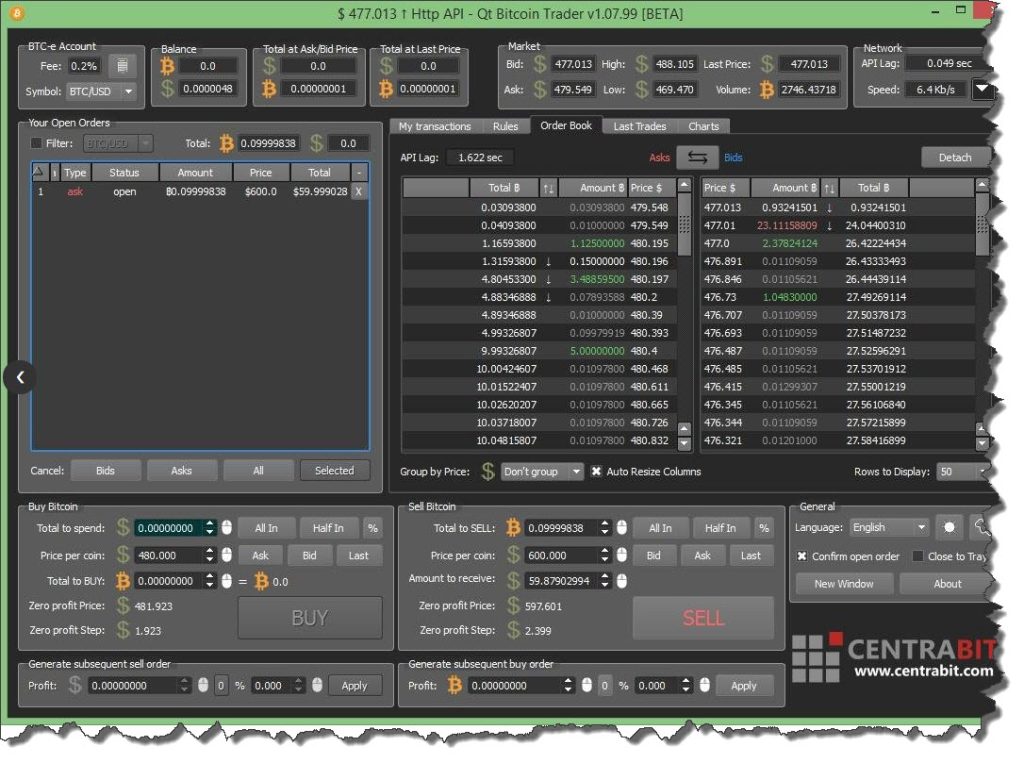It’s amazing how effective this blueprint is, and how commonly we see it (often without realizing what it is) – yet how few of us pursue it or even consider it.
What I’m talking about specifically is taking already developed software that has appropriate commercial use rights, such as Open Source, packaging it up, branding it, and selling it.
This is something I’ve done many times, and in fact, was where one of my earliest big successes came from.
From the “Imagine That!” department:
While doing the research to fill out these blueprints, I learned that “Screen show Pro” (a screen capture video program I “developed” using this method and marketed more than eight years ago) is still being sold – successfully – today!

Premise & Summary
Within the ‘digital marketplace’, there is a definite hierarchy of perceived value. At the low end of the ‘price-to-value’ scale are basic ebooks & reports.
Create or include audio and/or video, and the perceived price-to-value climbs.
At the top end of the digital marketplace is software; for many reasons, it has the highest perceived value, and as such can command the highest price.
There are good reasons for this; among them is that software is generally much ‘costlier’ to develop than content.
This Blueprint takes advantage of this – but does so without incurring those development costs.
We do this by finding market-ready or near-market-ready software that is under an “Open Source” license, which means it has rights allowing anyone to use, modify, and/or sell it.
There are numerous sources for Open Source software such as Source Forge and the Open Source Initiative.
Some easy-to-do market research will tell us what’s in demand and what’s selling well. Based on that research, we then find a suitable product.
We polish it up & package it, often just by outsourcing a new ‘skin’, then bring it to market!
Adding Value
I’ve heard a few people voice the notion that “selling someone else’s software/content/etc adds no value”.
I’ll address that in two ways:
First, and most obviously, no one would have the same concerns over distributors or ‘middlemen’, in part because their value-add is more obvious – they are providing distribution that a manufacturer may not otherwise have.
But more to the point, there are many ways of adding value in this blueprint. Among them, and what I’ve done most often, is to provide (create via outsourcing) a better interface (GUI) that provides a better and more effective experience with the software.
I also put some effort into creating better documentation, which often is created by programmers and is less-than-user-friendly to laypeople.
There are also opportunities to provide use-cases, provide support by way of aggregating FAQ’s and comments, and provide screen-capture video ‘how to’ walk-throughs of the software.
In the case of “ScreenSho Pro” mentioned below, I did all these, and I also spent a few bucks having a freelance programmer add some features.
I try to add value in everything I do, and this Blueprint is no different.
The choice is yours: you can make a lot of money simply researching, repackaging, and distributing ready-made software, or if you chose, you can put some additional effort into adding more value.
The Blueprint
Step 1– Market Research / Market Awareness
We can apply a ‘traditional’ market research approach, using market research tools & tactics, but there’s a better and more effective way: using some of the digital marketplaces to see what’s currently selling.
Go to http://www.warriorplus.com/ – if you don’t already have one, you’ll need to create a free account.
Now go to ‘Affiliate’ / ‘Offers’. You’ll see a table listing available offers, along with price, commission rate, refund rate, and more. Of concern to us is the ‘Sales’ column showing how many sales the offer has had.
Click on ‘Sales’ to sort the offers by sales volume (note: the top few shaded offers are ‘sponsored’ – the vendor is paying to have them appear at the top of the list. The actual sorted list begins just below them).
You’ll also want to slick the ‘Software’ icon under “Filter” so that you’re listing only software offers.
Finally, click the “Search” button.
The first few pages will show you offers with sale of 1000 units or more. Browse through these, noting which ones are for software. This will give you a sense of what software is most in demand.

* TIP *
I can tell you from both direct and indirect experience that WordPress plugins, WordPress themes, data scrapers, ‘viral’ account creators & submitters, and mobile apps (or almost anything mobile) are always in high demand.
Clicking through some of these will start to give you a sense of what’s selling on this marketplace (Warrior Plus), but I should note – these are products created & targeted to a fairly specific and narrow audience: affiliates in the internet marketing (‘IM’) space.
IM is a large and robust space, but it is just a ‘corner’ of the actual market for software. That said, one of the big advantages of this market is the ready army of affiliates who can promote your product(s) to their “lists” – prefab audiences that a given affiliate is already communicating with, typically via an email list, or their blog, Youtube channel, Instagram or Facebook group, etc.
* TIP *
Most of the products listed on Warrior Plus will have an accompanying “JV Page” (“JV” = “Joint Venture partner”, otherwise known as… an affiliate).
This page will have info from the product creator to help affiliates market their product.
Finding a product listed here that is similar or related to one you ‘develop’ and viewing it’s “JV Page” can give you hugely valuable insight for marketing your product.
Plus, you will also often see a “Funnel” link that shows you their exact sales funnel – their purchase path with whatever upsells/downsells/cross-sells they have set up.
All of this can be used to inform & optimize your own sales process!
Warrior Plus is far from the only marketplace to do your initial market research.
A larger (arguably the largest) and more comprehensive ‘digital marketplace’ is Clickbank.
The Clickbank Marketplace lists thousands of digital products across virtually every niche category, many of them software.
You can do similar market research on Clickbank, but instead of sorting by ‘Sales’, you would sort by ‘Gravity’, Clickbank’s running tally of a product’s success with affiliates.
NOTE: “Gravity” is not the same as “Sales”. It’s a rough measure of how many affiliates have made sales of the product in the prior 12 weeks. As such, a product with low ‘Gravity’ can still be a winning product with big sales numbers, it just means the vendor isn’t using – or succeeding with – affiliate channels to sell through.
Once you’ve done your research and have a sense of what category, niche, or product type you want to pursue, it’s time.
Step 2 – Choose Your Software
Browse through available software listings and choose the software you’ll package and sell.
- Source Forge – http://sourceforge.net/
- Open Source Initiative – http://opensource.org/
- Free Software Directory – http://directory.fsf.org/wiki/Main_Page
- Open Source Software Directory – http://www.opensourcesoftwaredirectory.com/
IMPORTANT: While “Open Source” is by definition re-distributable, you always want to double-check the specific licensing terms. In particular, you want to make sure it is usable under a ‘commercial’ license, meaning you can sell it and keep the money! Almost everything you see on these sites will be usable as such, but check to be sure.
Fortunately, one of the most popular licenses for ‘open’ software is the “gnu” license.
Here is the unambiguous position on selling “gnu”-licensed Open Source software, right from the ‘horses mouth’, the “Free Software Foundation”, the principle sponsor of “gnu”:
“Many people believe that the spirit of the GNU Project is that you should not charge money for distributing copies of software, or that you should charge as little as possible — just enough to cover the cost. This is a misunderstanding.
Actually, we encourage people who redistribute free software to charge as much as they wish or can. If this seems surprising to you, please read on..”

From “The Free Software Foundation”, the organization that manages GNU GPL, one of the common licenses you’ll encounter when looking for free software:
“The GNU General Public License (GNU GPL) has no requirements about how much you can charge for distributing a copy of free software. You can charge nothing, a penny, a dollar, or a billion dollars. It’s up to you, and the marketplace.”
IMPORTANT: In some cases, particularly if your source is under GNU license, you are required to carry forward the GNU license.
Step 3 – Customize & Package
Customize your software package so that it is unique to you. Depending on what you start with, this could be done by having a new ‘GUI’ or skin created, an attribution such as for WordPress plugins & themes, possibly new configurations or features.
You can do this by outsourcing to a programmer on any of the freelance sites such as Fiverr.com, Upwork.com, or Freelancer.com.
In most cases, the type of customization you’ll want to do can be done relatively quickly & cheaply. All told, I spent around $100 creating ScreenShow Pro; appx. $50 to have a graphic artist create the graphics that became the programs’ GUI, another $50 or so hiring a programmer to embed those graphics, and to create an installer, and $10 for the domain name.
(Although that was almost 15 years ago, I did some quick & dirty research while updating this post and estimate that even today it would cost me no more than a couple of hundred bucks outsourcing those same tasks.)
You’ll also want to modify or create instructions or user manual as appropriate; this can be done very simply by taking what already comes with the software or is on the site, and creating a PDF.
You can add value to the package by creating some screen-capture videos demonstrating the software, it’s installation, features, etc.
Variations I’ve Tried
In some venues, you can sell different levels of rights to your software very effectively. One example is Warrior Forum. If you are pricing your software relatively inexpensively, $10-$25 for instance, you can bump your revenue and perceived value by offering broader rights at a higher price.
If your software is something used on multiple sites, such as a word press theme or plug-in, you can try selling a developer’s license that explicitly allows unlimited use. This works well priced at 1.5 to 3 times the base cost.
You can also offer resale rights for 3 to 5 times the base cost, or more. I did this with ScreenShow Pro, adding half again as much revenue as it had already earned.
Another variation I’ve had success with is less a ‘variation’, and more a ‘different but related’ effort: outsourced software development.
As I did my market research, I would on occasion come upon an idea or opportunity for which I wasn’t able to find suitable Open Source material. This was mostly is the area of add-ons to new platforms or add-ons that would take advantage of changes or new trends.
Specifically, I saw opportunities for Shopify apps, and WordPress plugins, that either didn’t exist, or what did exist missed the mark for what my market research would turn up.
With some experience and familiarity outsourcing to freelance programmers under my belt, it wasn’t a great leap to have something developed entirely from scratch.
Variations I Haven’t Tried
Another option that I know to be effective though I haven’t tried it myself is to partner with marketers or developers that have similar or complementary offers.
For example, if you are doing WordPress themes or plug-ins, you might consider finding partners that have established, branded products, and approaching them with a licensing offer. This could take the form of offering to let them brand your product and include it with theirs, paying you a per-sale royalty.
They get the benefit of additional differentiation and adding further value to their product, you get the benefit of additional sales avenues.
Wrap Up
Once again, these Blueprints are based entirely on actual, real-world efforts. They have been working and generating revenue, in some cases, for years.
But as with most things worth doing, they require time and effort. Nothing happens by itself.
I’ve provided you with a set of plans that are tested & proven, but you have to put in the work to make them work. This leaves you with two choices:
- Do nothing and get nothing, OR…
- Do what we do and get the results we get.

